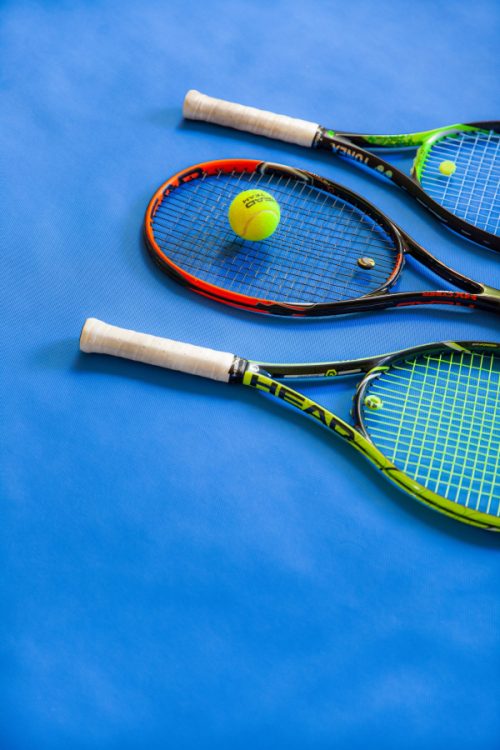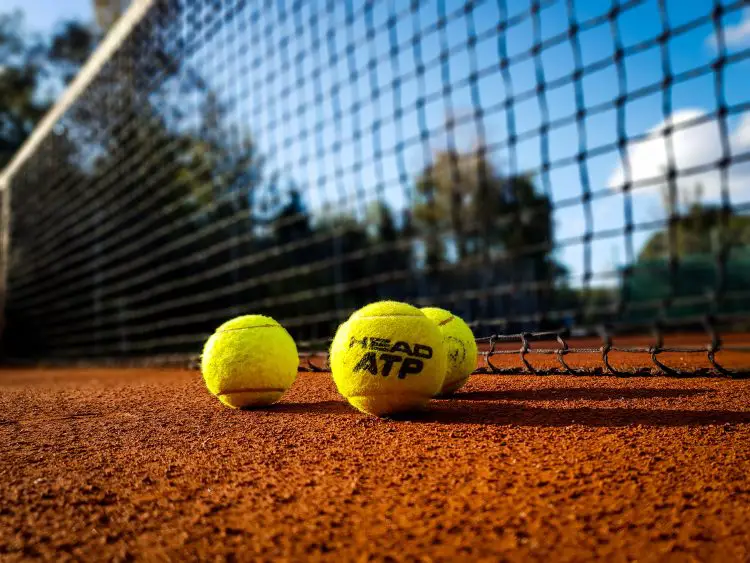Hey! This site is reader-supported and we earn commissions if you purchase products from retailers after clicking on a link from our site.
There is no official clock in tennis like there is in other sports. A match can take several hours, but a set might take only ten minutes. The length, therefore, is dependent on the number of sets that get played. This might sound kind of complicated, but once you know the answer to how many sets in tennis are played, things get a lot easier.
The majority of tennis matches use a best-of-three game play, including doubles, amateur, club, and USTA matches. This means that two sets are needed to win a match. However, Grand Slam tournaments have a slightly different setup: the best-of-five.
What Is a Set in Tennis?
In a game where “love” stands for zero, you might find determining what a set is to be difficult. For that reason, here is a crash course in scoring to give you a good foundation. First off, a tennis player must score 4 points to win. However, these points are not counted as 1, 2, 3, and 4 but as Love, 15, 30, and 40. The next score wins the game.
Deuces are when the score is 40-40, meaning a player has to win by two points. The first point scored after a deuce is called an advantage.
To win a set, you must win 6 games and be ahead by two. In other words, both players can each have won 6 games and require a tiebreaker before someone wins a set. You could also end up winning 5 games in a row, lose the sixth, and then win the seventh, putting you ahead of your opponent, and thus, winning the set.
Check out this video explaining sets in tennis:
Therefore, a set is the third unit of scoring above a game in tennis. Now you know where the phrase “game, set, match” comes from.
Explaining the Different Kinds of Sets
Although there are best-of-three and best-of-five formats that have been adopted by the professional organizers, there are a couple other set formats for amateurs. Let’s take a look at all the kinds of sets you can set up:
Best of 3
The most common number of sets in a tennis match. There are typically 6 games per set and a tiebreaker if the games are tied 6-6. If the first two sets are split between the players, then the third and final set is used to determine who is the winner. This is the format utilized by professional matches. It can be challenging and physically taxing to work at this pace, but it is also the most exciting to watch.
2 Out of 3 Sets and Tiebreaker
Although similar to the best of three format, this one has a 10-point tiebreaker added on. The tiebreaker is used when the players have each won a set. This format is popular when players want to preserve energy with shorter matches. Tournaments will use this to keep the matches moving quickly, ensuring sets do not last too long.
Here are some numbers: a full set may last up to an hour or longer. However, the 10 point tiebreaker can whittle that time down to 15 minutes.
4 Game Short Set
Here is a relatively new set format that has been accepted by a couple of professional-level tournaments, including the Next Gen Finals. This format uses a best 3 out of 5 format but has only 4 games per set. For instance, if players have tied at 3 games each, then a 5-point tiebreaker is used to see who wins the set.
The tennis match is much more dynamic this way and is easier to watch on television.
The 8 Game Pro Set
This format is the same as a best-of-three, but it uses 8 games instead. Should players end up 7-7, the set becomes 9 games. If the players then get to 8-8, they play a tiebreaker.
The History of Five Sets in Tennis
Did you know that the best-of-five sets used to be much more popular than it is today? Not too long ago, ATP Tour Masters Events used to all be five sets. The other matches within the tournaments would have three sets. Then, in 2007, that was permanently changing, making every match a best-of-three.
There is a reason for these shorter matches. First, you can thank the media, which includes commercial breaks. Since five-set matches seem to go on forever between media coverage and commercials, they are seen as less exciting. In other words, the shorter the match, the more intense and fan-friendly it becomes.

Secondly, shorter matches up the ante. During a longer match, a more seasoned player is able to find the rhythm and, ultimately, stick it out until they can sink a final point. Shorter matches allow for upsets to happen, increasing the competitiveness between the players. A lot can happen during a shorter match, but it is easier for players to stay mentally focused and driven during a shorter match, too.
Thus, only a handful of matches are best-of-five these days.
How Many Sets in a Professional Tennis Match?
As mentioned earlier, the number of sets in a tennis match depends on the kind of event. Various aspects influence scoring, including singles or doubles, the organization, and size of the tennis event.
ATP vs WTA Sets in Tennis
Traditionally, men’s and women’s events in tennis have slightly different scoring. Most events that are held by the Association of Tennis Professionals (ATP) have rules that are separate from those events organized by the WTA, or Women’s Tennis Association.
Because of this, men’s matches may have more sets. Recently, though, there has been a push to adopt best-of-three or best-of-five for both men and women during tours or Grand Slams.
For now, the majority of men’s professional matches use a best-of-three (3 sets), each with 6 games, and one possible tiebreak at the end. The four major tournaments—Australian Open, French Open, Wimbledon, and US Open—the men’s matches are 5 sets. To win, a player must win 3 out of the 5.
Women have all best-of-three matches, including Grand Slams. Each match consists of 3 sets, 6 matches per set, and a tiebreak, if needed.
How Many Sets in a Singles Event?
There are numerous singles events throughout the year for recreational, amateur, and professional tennis players around the world. For the most part, recreational and club matches use the best-of-three format.
Here are some further details on singles events and the number of sets in each:
ATP & WTA Tours
Tours are smaller in size and grandeur than Grand Slams but are more significant than Challenger and Futures events. Typically, tours are open to players ranked 1 through 250. Regardless of whether it is a qualifying or main draw match, men and women both play a best-of-three sets. In most ATP and WTA tours, the third set will have a tiebreak if players are tied at 6 games.

As previously noted, ATP 1000 matches used to be a best-of-five, but the calendar became too demanding for such lengthy matches. Now, all tours follow the best-of-three.
Singles Grand Slams
One of the most watched tennis events in the world, Grand Slams are where the top contenders bring the heat. Since there are only 4 Grand Slam tournaments every year, the competition is fierce. Matches can also be long, some of them going for 6 hours or more.
Main draw matches for the men use the 3 out of 5 set format. Qualifying draw matches for the Australian, French, and US Opens each require the players to win 2 out of 3 sets. Wimbledon is the exception to this—men play 2 out of 3 until the final qualifying round, which is when a best 3 of 5 sets is used. From then on, they play 5 sets. Grand Slams for women are all best-of-three, regardless of the match type.
Keep in mind that Grand Slams are not governed by the ATP and WTA but by the International Tennis Federation (ITF), which makes its own rules.
Each Grand Slam also has differing rules during the 5th set of the main draw matches. For the Australian and US Opens, the players have a tiebreak if they reach a tie at 6 games each. Wimbledon has a tiebreak when reaching 12 and 12 games apiece. For Roland Garros (the French Open), the first player who reaches a 2-game margin during the fifth set wins. There is no tiebreak. So, a player could win if they are at 6-4, 8-6, or 7-5 games.
Challengers and Futures Events
Anyone who aspires to become a professional tennis player starts off at Futures or Challenger events. In both events, men and women both have a best-of-three match during the main draw. Qualifying draws include a 2 out of 3 format with a 10-point tiebreak during the final set, if needed. This is a relatively new rule from 2019 to shorten matches for the qualifying players.
Shortening the qualifying matches ensures that those who make it to the main draw are not too exhausted.
How Many Sets in Tennis Doubles?
While doubles are underrated on TV, they are far more dynamic to watch. While it may not seem so while viewing a game, doubles matches are shorter than singles. Most doubles matches use the best-of-three sets, as well as a 10-point tiebreak. For the French, US, and Australian Open tournaments, men and women teams use a best-of-three sets with 6 games per set. At Wimbledon, the women’s matches follow the same format. Men’s doubles use a best-of-five.
Doubles Tours
There are many doubles tournaments throughout the year, in between the four Major tournaments. Usually, when famous singles players join in on a doubles match, it generates a lot of interest (and revenue). This is part of the reason doubles matches are shorter than singles matches—professionals did not want to jeopardize their singles performance while playing in doubles.
Thus, for doubles tours, both men’s and women’s matches use the 2 out of 3 format. A 10-point tiebreak is used instead of a third and final set.
Doubles Futures and Challengers
In Futures and Challengers events, there are so many contestants to get through that it is unrealistic to have full matches. Thus, Futures and Challengers follow the same format as doubles tours: a best 2 out 3 sets, with a 10-point tiebreaker for the last set.
Now You’re All Set
How many sets in tennis matches? Depending on the event, it is usually either a best-of-three sets or a best-of-five sets. The number of games per set, as well as tiebreakers may change the length of a game. Yet, for the most part, the number of sets in a tennis match are usually either 3 or 5.

Leave a Reply